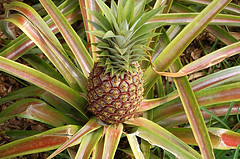Pineapples
| Infobox on Pineapples | |
|---|---|
| Example of Pineapples |  |
| Freshness facts | |
| Optimum carrying temperature | 10°C to 13°C (mature green) 7°C to 10°C (turning) 7°C (ripe) |
| Highest freezing point | -1,1°C |
| Acceptable product temp. at loading into containers | Max. 2°C above carrying temperature |
| Optimum humidity | 90% |
| Ventilation setting for containers | 25 m³/hr |
| Storage life | 3-4 weeks (mature green/turning) |
| Climacteric / non-climacteric | Non-climacteric |
| Ethylene production | Low |
| Ethylene sensitivity | Low |
| Modified / controlled atmosphere | 5%-10% CO2; 2%-5% O2 |
| Potential benefits | Increased CO; slight to moderate Reduced O2; slight |
| Availability | |
| On demand | |
Pineapples
Contents
Harvesting and handling
Pineapples are graded by degree of skin coloration, size (weight), absence of defects and disease, and uniformity of these characteristics before packing. Other characteristics include maturity, firmness, nice shape, flat eyes, well-cured broken stem (peduncle), and a minimum SSC of 12%. Crown size is a crucial grade component, with a minimum size, and ratio of crown:fruit length (0.33 to 1.5) for higher grades.
Pineapple fruit must have a desirable size and shape, with flat ‘eyes’ (individual fruitlets) and crown leaves that look fresh and are deep-green. High shell colour is not always a good measure of sweetness. Negative characteristics include: dry, brown crown leaves; dull, yellow skin appearance; presence of mould on the surface or cut stem; and fruit having an unfirm feel.
Maturity indices are change of shell color from green to yellow at the base of the fruit. Pineapples are non-climacteric fruits and should be harvested when ready to eat. A minimum soluble solids content of 12% and a maximum acidity of 1% will assure minimum flavor acceptability by most consumers.
Quality indices are:
- Uniformity of size and shape
- Firmness
- Freedom from decay
- Freedom from sunburn, sunscald, cracks, bruising, internal breakdown, endogenous brown spot, gummosis, and insect damage
- Tops (crown leaves): green color, medium length, and straightness
- Range of soluble solids = 11-18%; titratable acidity (mainly citric acid) = 0.5-1.6%; and ascorbic acid = 20-65 mg/100g fresh weight, depending on cultivar and ripeness stage
The packaging must allow sufficient ventilation of the pineapples, since stagnant air around the pineapples encourages mould growth. This is ensured by perforations in the sides and the top and bottom of the cartons. As pineapples are sensitive to bruising and impact damages, the mode of packaging has to be adopted accordingly.
Cooling and storage
At temperatures > 10°C, the crown leaves have an increased tendency to bolt. Bolted crown leaves impart a tired appearance to the fruit and diminishes its value. In addition, the tendency to fruit rot (black rot) also increases, often occurring as butt rot above the stem but also arising in the crown. Susceptibility to chilling damage reduces as ripeness increases.
Exposure of pineapples to temperatures below 7°C results in chilling injury. Ripe fruits are less susceptible than unripe or partially-ripe fruits. Symptoms include dull green colour when ripened (failure to ripen properly), water-soaked flesh, darkening of the core tissue, increased susceptibility to decay, and wilting and discoloration of crown leaves.
Mixed loads
Pineapples readily absorb off-odours from avocados and green peppers. They are neither sensitive to ethylene nor great producers of ethylene. Pineapples can be shipped with citrus fruit provided the shipping temperature is suitable for both products.
Cautions
O2 below 2% can cause off-flavours. CO2 above 10% can also cause off-flavours. Less mature fruit are more susceptible to chilling injury and should not be kept below 10°C while ripe fruit may be held as low as 7°C.
Storage disorders
Aspergillus rot, Bacterial soft rot, Black rot, Botryodiplodia rot, Core rot, Chilling injury, Internal browning, Rhizopus rot, Yeasty rot.











